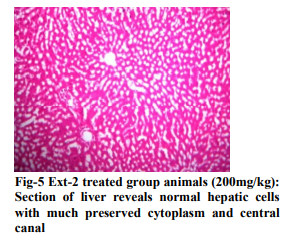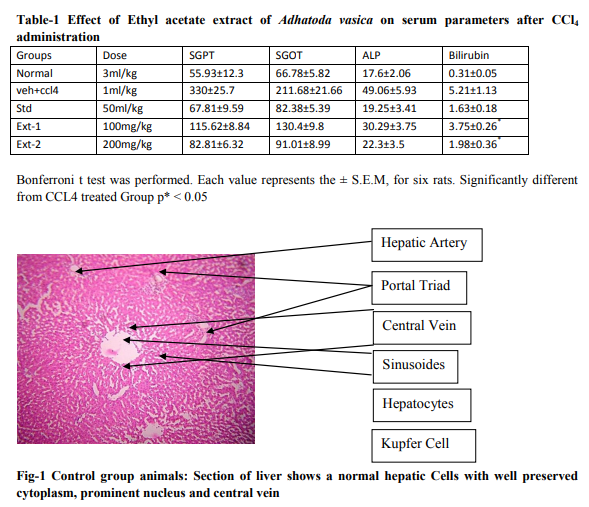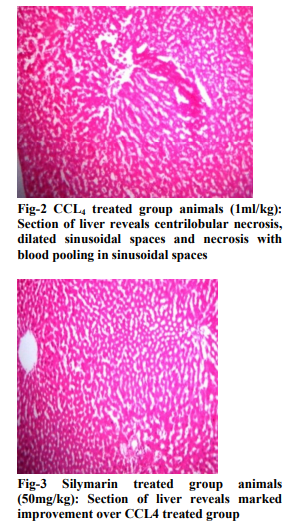IJCRR - 5(6), March, 2013
Pages: 16-21
Date of Publication: 30-Mar-2013
Print Article
Download XML Download PDF
HEPATOPROTECTIVE ACTIVITY OF ETHYL ACETATE EXTRACT OF ADHATODA VASICA IN SWISS ALBINO RATS
Author: Rayese Ahmad, Vaseem Raja, Manik Sharma
Category: Healthcare
Abstract:The hepatoprotective activity of Ethyl acetate extract of Adhatoda vasica was investigated against CCl4 induced liver damage in Swiss albino rats. At the dose of 1ml/kg, CCl4 induced liver damage in rats as manifested by statistically significant increase in serum Alanine aminotransferase, (ALT), Aspartate aminotransfrase (AST), Alkaline Phosphatase (ALP) and also in serum Bilirubin. Pre-treatment of rats with the ethyl acetate Extract of Adhatoda Vasica (100mg/kg and 200mg/kg) prior to the CCl4 dose at 1ml/kg statistically lowered the three serum level enzymes and also Bilirubin. Histopathlogical observations also coincided with the above results, however 200mg/kg dose was found to be more active. Current results suggest that Ethyl acetate extract of Adhatoda vasica has potent hepatoprotective effect against CCl4 - induced liver damage.
Keywords: Adhatoda vasica, CCl4, silymarin and DMSO.
Full Text:
 INTRODUCTION
INTRODUCTION
Liver is one of the largest organs in the human body and the chief site for intense metabolism and excretion. So it has the surprising role in the maintenance, performance and regulating the homeostasis of body. It is involved in almost all biochemical path ways to growth, to fight against infections, diseases, nutrient supply, energy provision etc. The major functions of liver are carbohydrate, protein and fat metabolism, detoxification, storage of vitamin and formation of bile. Unfortunately, conventional or synthetic drugs used in the treatment of liver diseases are inadequate and some times can have serious side effects. Drug induced liver injury is a major health problem that challenges not only health care professionals but also the pharmaceutical industry and drug regulatory agencies.1 The rate of hepatotoxicity has been reported to be much higher in developing countries like India(8-30%) comp aired to that in advanced countries(2-3%) with a smaller dose schedule2 . The use of medical plants to treat human diseases has been performed for millenniums. Now days it is known that 80% of the world populations have already taken medicinal plants and 30% are prescribed by physicians. To prove the traditional claims, the hepatoprotective activity of Adhatoda vasica was evaluated. Adhatoda vasica (common name- Malabar nut, Family- Acanthacea) is a small ever green plant (1-1.25m) with broad lanceolate leaves. The flowers are white, pink or purple. The plant grows through out the Indian pensula up to an altitude of 1300m3 . The biological work performed so for on this plant showed poultice on rheumatic joints as counter-resistance on inflammatory swelling on fresh wounds, urticaria and in neuralgia4 . The present investigation has been designed to study the hepatoprotective activity of Ethyl acetate extract of the whole plant of Adhatoda vasica in carbon tetrachloride induced hepatic damage in rats.
MATERIAL AND METHODS
Plant material
The plant of Adhatoda vasica was collected from remote areas of Bhopal district, during Dec. 2010. Identification of plant was carried out at department of Botany Bhoj Mahavidhyalya Bhopal. A voucher specimen has been deposited at the Herbarium located at postgraduate department of zoology Bhoj Mahavidhyalya Bhopal. Preparation of plant extract The whole plant of Adhatoda vasica was washed thoroughly with tap water, sun dried and powdered. The powder (100gm) was successively extracted with 90% ethyl acetate in soxhlet apparatus for 48 hours duration. The filtrate was then concentrated and the solvent was evaporated under reduced pressure in a Rotatory evaporator. The yield of the extract was found to be 25.89%. This crude extract was referred to as AV. For administration the crude extract was dissolved in DMSO and used for the experiments. Experimental animals Swiss albino male rats (150-175gms) obtained from the animal house of PBRI. They were housed under the standard laboratory conditions and were feed commercial rat feed (Lipton India Ltd, Mumbai, India) and water, ad libitum. All animal experiments were carried out according to NIH guide lines after getting approval of the institute’ s Animal Ethics Committee (Regd No.1283/c/09 CPCSEA). Carbon tetrachloride induced hepatotoxicity CCl4 was suspended in olive oil and administered p.o, at a dose of 1ml/kg. Healthy rats were divided into five groups (six per group). Group 1, the normal control group received a single dose of DMSO (3ml/kg p.o) for 7 days. Group 2, the CCl4 intoxicated control group received a single dose (1ml/kg bw,p.o). Group 3 received drug silymarin (50mg/kg,bw) for 7 days and a single dose CCl4 (1ml/kg,p.o.) on seventh day. Group 4 and 5 received AV (100and 200mg/kg, bw, p.o) and a single dose of CCl4 (1ml/kg) on the seventh day. The animals were scarified after 24 hours of last treatment. The blood samples from all groups were collected separately by retro orbital puncture and allowed to coagulate for 30 min at 37 oC, the clear serum was separated at 8000 rpm for 10min and subjected to the liver function tests. Liver function tests Biochemical parameters like serum glutamate pyruvate transaminase5 (SGPT), serum gultimate oxaloacetate transaminase5 (SGOT), serum alkaline phosphatase6 (SALP) and serum Bilirubin7 (SB) were assayed according to the standard methods. Histopathological studies After blood draining liver samples were excised from the control and treated groups of animals and washed with normal saline separately. They were suspended in 10% formalin for 24 hours. The formalin-fixed liver samples were stained with haemtoxylin-eosin for photo microscopic observations of the liver histological architecture.
STATISTICAL ANALYSIS
Statistical comparison between control and treated groups was made, Analysis of variance, followed by multiple comparisons 8 .
RESULTS
Administration of the CCl4 (1ml/kg p.o) caused a significant increase in serum enzymes namely SGOT, SGPT, ALP and SB in rats, as compared to normal rats. However pretreatment with plant extract AV, prior to CCl4 administration caused a significant reduction in the values of SGOT, SGPT, SALP and SB, however 200mg/kg dose brought reduction almost comparable to silymarin(50mg/kg) treated groups (table-1) The hepatoprotective of AV was further confirmed by histopathological examinations of the liver samples from respective groups. Histological architecture of CCl4 treated liver sections showed degeneration of hepatic cells with centrilobular necrosis. Sinusoids were observed to be inflamed and flooded with inflammatory cells. However, administration of AV (200mg/kg) almost normalized these defects in the histological architecture of the liver resembling that of silymarin treated groups, showing its potent hepatoprotective effects (Fig 1-5).
DISCUSSION
Herbal based therapeutics for liver disorders has been in use in India for a long time and has been popularized world over by leading pharmaceuticals. Despite the significant popularity of several herbal medicines in general, and for liver diseases in particular, they are still unacceptable modalities for liver disease. The efficacy of any hepatoprotective drug is essentially dependent on its capability to either reduce harmful effects or to maintain the normal hepatic physiological mechanism that have been un balanced by the hepatotoxin9 . The result of the present study reveal that the Ethyl acetate extract of Adhatoda vasica possess significant hepatoprotective activities against CCl4 induced liver damage in Swiss albino rat. It has been observed that the CCl4 is bio-transformed by the cytochrome p-450 system to the trichloronethyl free radical; this free radical may react again with oxygen to form a trichloromethyl per oxygen radical which may attack lipids on the membrane of endoplasmic reticulum10. Trichloromethyl per oxygen free radical leads to lipid per oxidation, the disruption of ca++ homeostasis and finally results in cell death11-12. Therefore the leakage of large quantities of enzymes into the blood stream is often associated with massive necrosis of the liver. Administration of CCl4 results in the rapid increase in the serum GOT, GPT and ALP (table1) .Serum GOT can be found in the liver, cardiac muscles, kidney , brain , lungs, skeletal muscles ,leukocytes and erythrocytes (in decreasing concentrations)13 . Whereas the highest concentration of serum GPT is found in liver tissues, serum GPT occurs in two locations, the cytosol and mitochondria. Serum GPT appears to be more sensitive and specific test for hepatocellular damage than serum GOT. Although the serum enzyme levels are not the direct measure of hepatic injury, they show the status of the liver. The elevated levels of enzymes are indicative of cellular leakage and loss of functional integrity of cell membranes in the liver14. Thus lowering of enzyme content in serum is a definite indication of hepatoprotective action of a drug. Serum ALP and Bilirubin levels are also related to the status and function of hepatic cells. In the present study Ethyl acetate extract of Adhatoda vasica has been found to reduce the serum level enzymes and Bilirubin in the treated groups compared to untreated ones in dose dependent manner (Table-1). The liver sections treated with AV also showed the normal hepatic cell architecture and portal triad coincides with serum levels. The serum and histopathological results confirm the hepatoprotective activity of Adhatoda vasica. Thus may be the best remedy for treatment of liver disease in developed as well as in developing countries. The results coincided with our investigations that200mg/kg b.w showed the best protective effect against the carbon tetrachloride induced liver injuries, therefore the possible hepatoprotective mechanisms of extract of Adhatoda vasica may be due to preventing process of lipid per oxidation, inhabiting the cytochrome p-450 activity, stabilizing the hepatocellular membrane and enhancing the protein synthesis. Preliminary phytochemical studies have indicated the presence of flavonoids in Adhatoda vasica. Flavonoids consumed in large amounts in diet, are known to protect liver15. Hence the anti hepatic toxicity of Adhatoda vasica may due to presence of flavonoids.
CONCLUSION
On the basis of the present investigations it can be concluded that the ethyle acetate extract of Adhatoda vasica seem to poessess hepataprotective activity in rats, it is further demonstrated that 200mg/kg b.w. dose has prominent hepatoprotective activity as is evident from the biochemical and histopathological parameters. Further studies are needed to elaborate whether some compounds present in extract responsible for hepatoprotection I CCl4 induced hepatotoxicity and the molecular basis of their mode of action.



References:
1. Sobiya R., Vennila, J .J., Aiyavu, C. and Selvam, K.P. (2009). The hepatoprotective effects D of ancholic extract of Annona squamosa leaves on experimentally induced liver injury in Swiss albino mice.international Journal of Integrative Biology, 5 ( 3): 182- 190.
2. Shama, S.K. (2004). Antituberculosis drugs and hepatotoxicity . Infect Genet Evol. 4 : 167-170.
3. Claeson, U.P., Malmfors, T., Wikman, G. and Bruhn, J.G. (2000). Journal of Ethnophamacology, 72, 1-20.
4. Wealth of India, Raw Materials(1985). CSIR New Delhi, 1, 76.
5. Reitman, S. and Frankel, S. (1957). A colorimatric method for the determination of serum gultimate oxaloacetate and glutamic pyruvic acid transaminase. Amr J. Clinic. Pathol, 28: 56-62.
6. Kind, P.R.N. and King, E.J. (1954). Determination of serum alkaline phosphatase. J Clin Pathol, 7: 132-136.
7. Jendrassikl. and Grof, P. (1938). Verenfachte photometrishe method zur bestimmung des blubilirubins. Biochem Z, 297: 81-89
8. Armitage, P. and Berry, G. (1985). Statistical methods in Medical Research, 2ndEdn, Black Well Scientific publications, Edinburgh, UK, 186
9. AL – Howring, T.A., AL – Sohaibani, M.O., AL – Said., M.S., AL – Yahya, M.A., AL – Tahir, K.H. and Rafatullah, S. (2004). Hepatoprotective properties of Commiphora opobalsamum (Balessan), a traditional medicinal plant of Saudi Arabia. Drugs Exptl. Clin. Res, 5 (06): 213-220
10. Manokarn, S., Jaswanth, A., Sengotuvelus., Nandha, K.J., Duraisamy, R., Karthikeyan, D. and Mallegaswari, R. (2008). Hepatoprotective activity of Avera lanata against paracetamol induced liver damage in rats. Research of Pharm and Tech, 1(4): 398- 400.
11. Clawson, G.A. (1989). Mechanism of Carbon tetrachloride hepatotoxicity. Pthol ImmunoPathol Res, 8: 104-115.
12. Reknagel, R.O., Glande, E.A., Dholak, J.A. and Walter, M.A. (1989). Mechanism of carbon tetrachloride toxicity. Pharmacol Ther, 43, 135-140.
13. Rafatullah, S., Moosa, J.S., Ageel, A.M., Alyahya, M.A. and Tariq, M. (1991). Hepatoprotective and Safety evaluation studies on Sarsaparilla. Int J Phamacognosy, 29, 4: 296-301.
14. Susanta, S.K., Goutam, C., Malya, G. and Upal, K.M. (2005). Hepatoprotective activity of Diospyros malabarica Bark in carbon tetrachloride intoxicated rats. Europian Bulletin of Drug Research, 13, (1): 25-30
15. Di Garlo G, Mascolo N, Izzo AA and capasso F(1999). Flavonoids: old and new aspects of a class of natural therapeutic drugs. Life Sci., 65,(4): 337-353
|






 This work is licensed under a Creative Commons Attribution-NonCommercial 4.0 International License
This work is licensed under a Creative Commons Attribution-NonCommercial 4.0 International License